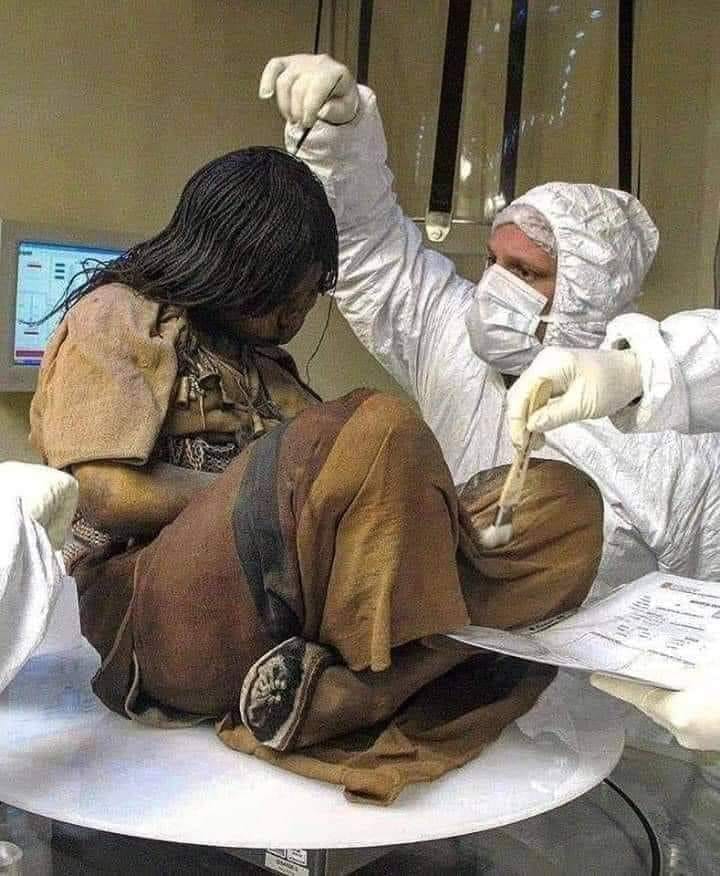In the majestic Andes Mountains, where the rugged winds carry whispers of ancient tales, an extraordinary archaeological discovery emerged in 1999. This finding offered an unparalleled glimpse into the past, unveiling a story of sacrifice, devotion, and nature’s incredible ability to preserve history. Among the discoveries was the Llullaillaco Maiden, a testament to the resilience of time and the spiritual richness of the Inca civilization.
At an astounding altitude of 6,700 meters (22,100 feet) on the Llullaillaco Volcano, situated along the border between Argentina and Chile, archaeologists uncovered a remarkable treasure: three perfectly preserved Inca children. The Maiden, distinguished by her remarkable state of preservation, captured the world’s imagination. These children had been participants in the capacocha ritual, an ancient Inca practice of human sacrifice intended to honor and appease the gods during times of crisis or significant events.

What makes the discovery so fascinating is the unparalleled state of preservation of the Maiden’s body. The extreme altitude of her resting place created a natural chamber for mummification. The icy, arid environment, coupled with low oxygen levels, halted the decay process, preserving her features, garments, and the artifacts around her for more than five centuries. Her serene expression and intricate clothing remain almost untouched by time, allowing us to witness a moment from a civilization that thrived centuries ago.
Scientific analysis has provided deeper insights into the Maiden’s final moments. Before her passing, she was given coca leaves and alcohol, substances likely meant to calm and sedate her. This detail highlights the compassionate elements of what might otherwise be perceived as a harsh ritual. It demonstrates the priests’ intention to ensure her peaceful transition into the afterlife, aligning with the spiritual beliefs of the Inca people.
The Maiden’s journey to becoming a sacred offering began long before her final moments. Archaeological studies of her remains and diet revealed that she was chosen for this role at least a year before her sacrifice. Her diet shifted from that of a commoner to one befitting the elite, with a notable increase in maize and meat consumption. This dietary change marked her transformation into a revered figure, chosen to serve as a bridge between the earthly world and the divine. The capacocha ritual was reserved for monumental events, such as natural disasters or the death of an emperor, signifying the Maiden’s exceptional status within the Inca society.
Alongside the Maiden were numerous artifacts, each telling its own story. Surrounding her body were meticulously crafted items, including miniature statues, intricately woven textiles, and ceremonial vessels. These offerings reflect the artistic and spiritual sophistication of the Inca civilization. Each object was selected with care, symbolizing the deep cultural and religious significance of the capacocha ritual.
Today, the Maiden of Llullaillaco, along with the two other children discovered at the site, resides in the Museum of High Altitude Archaeology (MAAM) in Salta, Argentina. The museum plays a critical role in preserving these invaluable finds while ensuring they are treated with the dignity and respect they deserve. The museum’s careful curation allows visitors to connect with the rich history of the Inca people and gain insight into their spiritual practices and relationship with the natural world.
The preservation and presentation of the Maiden’s story serve as a bridge between ancient rituals and modern understanding. Her discovery is not just a testament to the scientific marvel of natural mummification but also a profound reminder of the spiritual and cultural depth of the Inca civilization. The Maiden’s resting place, situated in one of Earth’s most inhospitable environments, underscores the incredible adaptability and ingenuity of the Inca people.
The Llullaillaco Maiden continues to inspire awe and curiosity. Through her, we glimpse the interplay between life, death, and spirituality in Inca culture. Her serene expression speaks volumes about the care and reverence with which the ritual was conducted. The artifacts accompanying her offer a window into the values, beliefs, and artistic achievements of a society that thrived in harmony with some of the most challenging landscapes on the planet.
The Maiden’s story is more than a tale of discovery; it is a narrative of human connection across time. The Inca civilization, with its profound devotion to the spiritual realm, reminds us of the universality of seeking meaning and purpose. Her preservation is a reminder of nature’s remarkable ability to safeguard history, providing modern society with a direct link to a past that is both distant and remarkably close in its shared humanity.
As the Maiden’s legacy endures, her story challenges us to reflect on the complex interplay between culture, spirituality, and survival. The preservation of her body and the surrounding artifacts is a testament to the meticulous planning and deep spiritual convictions of the Inca people. It also invites ongoing discussions about how ancient societies understood and interacted with their environment.
Through the efforts of researchers, historians, and curators, the Llullaillaco Maiden’s narrative continues to evolve. Her discovery is not just an archaeological achievement but a profound connection to a civilization whose echoes still resonate in the towering Andes Mountains. The Maiden’s serene presence and the artistry of the offerings that accompanied her remind us of the enduring power of history to inspire and teach.
In honoring the Maiden, we honor a civilization’s intricate tapestry of belief, art, and devotion. Her story bridges the gap between the past and present, offering invaluable insights into the resilience and ingenuity of the human spirit. The Llullaillaco Maiden stands as a timeless symbol of cultural preservation, reminding us that even in the most remote corners of the world, history continues to whisper its secrets to those willing to listen.





